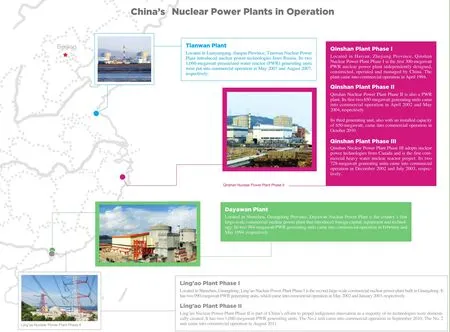PRESSING THE NUCLEAR RESTART BUTTON
2012-10-16ChinawillcontinuetosafelydevelopnuclearpowerafteroneyearconstructionhiatusByLanXinzhen
China will continue to safely develop nuclear power after a one-year construction hiatus By Lan Xinzhen
PRESSING THE NUCLEAR RESTART BUTTON

China will continue to safely develop nuclear power after a one-year construction hiatus By Lan Xinzhen
After a yearlong suspension, construction of nuclear power facilities across China may be starting up again, signaling the resumption of a 1-trillionyuan ($158.73 billion) nuclear investment across the country.
In February, Harbin Electric Corp., one of China’s major nuclear power equipment producers, received an order for the main components required in nuclear power generation from Tianwan Nuclear Power Plant,located in Lianyungang, east China’s Jiangsu Province. This was the first order since the country suspended nuclear power projects last March following the nuclear disaster at Fukushima, Japan.
Although nothing official has been announced, industry insiders say the suspension has been lifted, as the construction of the No.1 generating unit of Sanmen Nuclear Power Plant in east China’s Zhejiang Province restarted, and three nuclear power-related planning reports were recently submitted to the State Council for review.The reports are expected to be of fi cially released later this year.

Safety check
After the nuclear accident at Fukushima on March 11, 2011, Chinese Premier Wen Jiabao chaired a State Council meeting on March 16 and made four decisions on China’s nuclear power development: A complete safety check was required immediately on all nuclear facilities; approval of newly built nuclear power projects will be tightened; formulation of a nuclear safety plan will be accelerated; middle and long-term development plan of nuclear power will be readjusted, and before the plan is approved, approval of nuclear power projects, including preliminary work of the projects, should be suspended.
Following the meeting, a nation-wide safety screening on all operational and underconstruction nuclear power facilities was put into effect, with approval of some construction projects suspended outright. From April 15 to August 5, the comprehensive check group on national civil nuclear facilities jointly organized by the National Nuclear Safety Administration (NNSA) of the Ministry of Environmental Protection (MEP), the National Energy Administration (NEA) and some other departments checked all the country’s power plants.
The safety check drew lessons from the Fukushima accident, forcing many nuclear power operators to take a more aggressive approach to nuclear power safety.
On January 21, the generating units at the Ling’ao Nuclear Power Plant in south China’s Guangdong Province were upgraded, which ended on February 10. The overhaul showed that the plant was in good condition. Starting on February 12, the generators at Tianwan began a 50-day overhaul, including 8,436 checks on individual components and technological upgrades.
Wang Binghua, Chairman of the State Nuclear Power Technology Corp., said besides safety check of nuclear power facilities in operation, designing, equipment manufacturing and construction of projects with thirdgeneration AP1000 technology have been slowed down.
In fact, the AP1000 projects in Sanmen and Haiyang, east China’s Shandong Province are safer than second-generation technology used at Fukushima. But China still places safety, not just technology upgrading, as its top priority in the construction of the thirdgeneration nuclear power technology.
Capacity expanded
According to NEA’s Readjustment Plan of Middle and Long-Term Development of Nuclear Power, which has been submitted to the State Council for approval, China plans to install a total nuclear power capacity of 80 million kilowatts (kw) by 2020.
Donghai Securities Co. Ltd. estimated that at least 60 million kw of nuclear power installed capacity will be added by 2020, excluding the capacity under construction now,which will drive up investment by 1.2 trillion yuan ($190.48 billion).
A plan previously issued by the National Development and Reform Commission says by 2020 the proportion of renewable energy among primary energy consumption will reach 15 percent, but in 2011, the proportion was only 8.9 percent, and nuclear power only accounted for 1.038 percent of the country’s primary energy consumption.
Pan Ziqiang, a member of the Chinese Academy of Engineering and an expert of nuclear radiation protection and environmental protection, said the disparity will be made up for mainly through development of nuclear power, because most exploitable hydropower resources have been developed, leaving little potential for future development. Also,restricted by technologies and natural conditions, wind power, solar energy and biomass energy are unlikely to see rapid development.Compared with other clean energies, only nuclear power can be developed in a large enough scale to meet China’s energy needs.

An MEP news release showed that in the future China’s safety standards for nuclear power will be raised. The Nuclear Safety Plan completed by the MEP and submitted to the State Council mainly focuses on supervision so as to improve the safety of nuclear power facilities and nuclear power utilization, reduce risks of radiation, ensure operation safety and safety to the environment and public health, and push forward safe, sound and sustainable development of nuclear energy and technology.
China has also made changes to its supervision mechanism for nuclear safety. The NEA will set up a nuclear power department,the NNSA will increase from one department to three and the number of nuclear safety supervision personnel will increase by 1,000, the State Administration for Science, Technology and Industry for National Defense will also set up a department of nuclear emergencies.
Doubts remain
As China gears up to resume approval of nuclear power projects, arguments against construction of new nuclear power plants abound.
On February 7, a government document requiring the cessation of the nuclear power project construction in Pengze, Jiangxi Province attracted widespread attention on the Internet.The document was issued by the government of Wangjiang County, Anhui Province, as the project in Pengze sits along the Yangtze River, on the opposite shore from Wangjiang.
This report says Pengze nuclear power project will have hidden dangers if completed.
Establishment of Pengze nuclear power plant was approved two years ago, but was suspended by the State Council after the Fukushima accident last year.
The opposition of Wangjiang County Government is also supported by He Zuoxiu,an academician of the Chinese Academy of Sciences. He published articles opposing construction of nuclear power plants in the inland areas of the country, mentioning that problems such as construction of Pengze nuclear power plant will be blocked by drought and nuclear power plants in inland areas will pollute rivers.
Pan said this re fl ects the fact that people are still concerned about the safety of nuclear power plants.
“From the safety and nuclear safety standards, there is no difference between inland and coastal nuclear power plants. The site of Pengze nuclear power project is good, and in principle its safety is ensured,” Pan said.
According to Pan, China’s provisions on preventing and protecting against environmental radiation in nuclear-powered factories impose detailed requirements on site selection and safety standards of nuclear-powered factories. Pengze nuclear power project is located along the Yangtze River, which has plenty of water and is highly capable of diluting and diffusing pollutants.
At present, China has approved a total of 43 nuclear power plants, with a planned capacity of 200 million kw. These plants are located in 16 provinces, including eight inland provinces such as Jiangxi and Anhui.
It is unknown whether opposition from Wangjiang can successfully stop construction of the Pengze project, but according to information from the environmental protection authority,since there are still big disputes on the safety of building nuclear power plants in inland areas,China will temporarily suspend approval of building nuclear power plants inland.
The voice of opposition against nuclear power has always existed in China. An organization named Ocean Protection Commune once organized a signature campaign from March 2006 to January 2008 opposing construction of nuclear power plants, and sent the signatures in written and electronic forms to the MEP and the State Oceanic Administration.
According to a media release from the Ocean Protection Commune, labeling nuclear power as “clean energy” is a total lie.
The commune thinks that there are risks of leaks during the transportation of nuclear fuels. It is also hard to ensure safety in disposal of nuclear waste.
If war breaks out, the enemy state will be able to cause serious nuclear radiation by targeting nuclear power plants, said the release.
The organization says these are problems faced by all nuclear power countries and as of now there is no safe solution.
